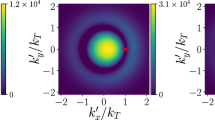Abstract
Information on the electronic states of disordered systems can be gathered from the analysis of the transport properties of excess electrons in a dense gas. the coupling of a quantum light particle to its environment may result in different equilibrium states, depending on the coupling constant between them and on the response function of the environment. a very important problem is that of an electron interacting with a gas of hard-spheres. One experimental realization of such a system is an excess electron immersed in dense he gas. at low gas density the equilibrium state of excess electrons is a propagating one. the electron wavefunction is pretty much delocalized and the interaction of the excess electron with the atoms of the host gas is treated witihin the formalism of kinetic theory by introducing the electron-atom scattering cross section1. the observed excess electron mobility is relatively high. by increasing the gas density, and thus changing the response function of the environment, it happens that the particle non-perturbatively alters its environment so as to give origin to a new equilibrium state which is completely different from the state in the decoupled system of particle plus environment. in this case the electron deforms self-consistently the gas density around itself, and, owing to the electron-He atoms repulsive interaction, its wavefunction becomes localized in a narrow region of space where the local gas density is lower than average. As a result electrons become self-trapped in a partially filled cavity dug out in the gas and the electron state is non propagating. in this case, however, the complex electron plus cavity can still have a diffusive motion because the gas is compliant to deformations. Experimentally, the process of self-trapping of excess electrons can be observed as a strong drop of the electron mobility2 as a function of density at constant temperature and it is a general behavior shown by gases, whose interaction with electrons is essentially repulsive. in fact, this self-trapping transition as a function of the gas density has been observed also in Ne 3. Detailed reviews can be found in literature4.
Access this chapter
Tax calculation will be finalised at checkout
Purchases are for personal use only
Preview
Unable to display preview. Download preview PDF.
Similar content being viewed by others
References
L. G. H. Huxley and R. W. Crompton, Tie diffusion and drift of electrons in gases (Wiley, New York, N.Y., 1974)
J. L. Levine and T. M. Sanders, Phys. Rev. Lett. 8: 159 (1962); H. R. Harrison and B. E. Springett, Chem. Phys. Lett, 10: 418 (1971) and Phys. Lett, A 35: 73 (1971); J. A. Jahnke, M. Silver, and J. P Hernandez, Phys. Rev. B12: 3420 (1975); K. W. Schwarz, Phys. Rev. B21: 5125 (1980)
A. F. Borghesani and M. Santini, Phys. Rev. A42: 7377 (1990)
J. P. Hernandez, Rev. Mod. Phys., B63: 675 (1991); A. F. Borghesani and M. Santini, in Linking the Gaseous and Condensed Phases of Matter. The Behavior of Slow Electrons., L. G. Christophorou, E. Illenberger, and W. F. Schmidt Editors, NATO ASI Series vol. 326,p.281 (Plenum, New York, N.Y. 1994)
A. M. De Riva, Ph.D. Thesis (University of Padua, 1994) unpublished; D. Neri, Ph.D. Thesis (University of Padua, 1997) unpublished
A. F. Borghesani, L. Bruschi, M. Santini, and G. Torzo, Phys. Rev. A37: 4828 (1988)
L. W. Martin, Ph.D. Thesis (University of North Carolina at Chapel Hill, 1991) unpublished
A. F. Borghesani, M. Santini, and P. Lamp, Phys. Rev. A46: 7902 (1992)
N. Mott, Conduction in non-crystalline Materials (Oxford University Press, Oxford, 1993)
V. M. Atrazhev and I. T. Iakubov, J. Phys., D10: 2155 (1977)
A. Ya. Polischuk, Physica, 124C, 91 (1984)
Author information
Authors and Affiliations
Editor information
Editors and Affiliations
Rights and permissions
Copyright information
© 1998 Springer Science+Business Media New York
About this chapter
Cite this chapter
Borghesani, A.F., Santini, M. (1998). Electron Mobility and Localization in High-Density Helium Gas in an Extended Temperature Range. In: Christophorou, L.G., Olthoff, J.K. (eds) Gaseous Dielectrics VIII. Springer, Boston, MA. https://doi.org/10.1007/978-1-4615-4899-7_12
Download citation
DOI: https://doi.org/10.1007/978-1-4615-4899-7_12
Publisher Name: Springer, Boston, MA
Print ISBN: 978-1-4613-7221-9
Online ISBN: 978-1-4615-4899-7
eBook Packages: Springer Book Archive



